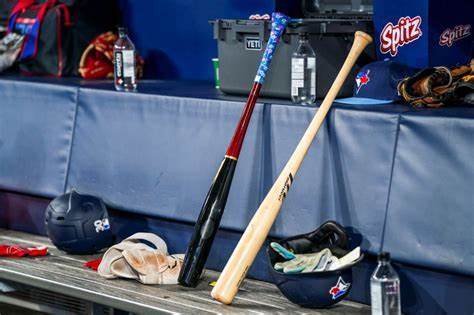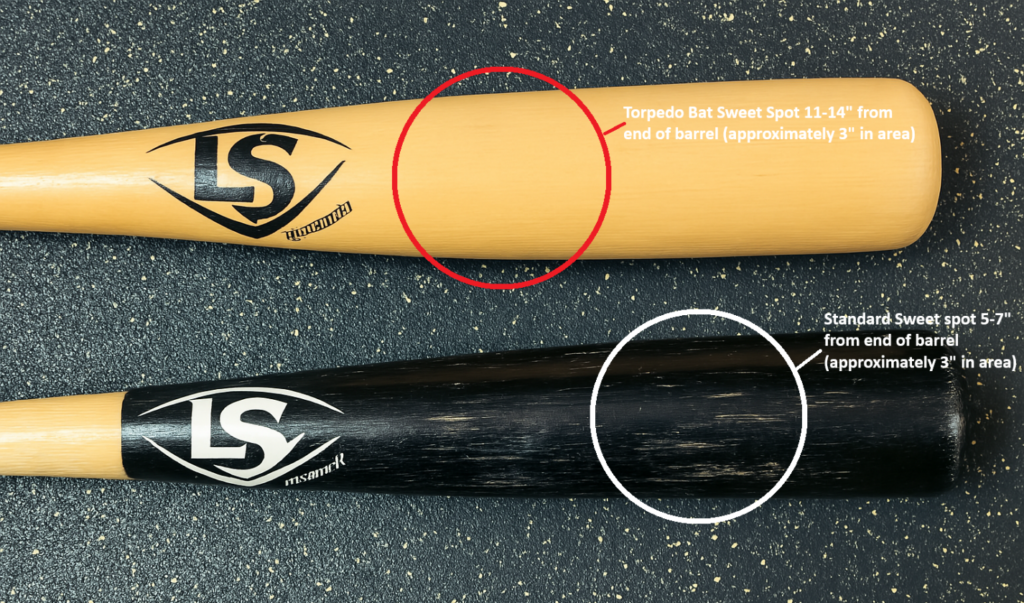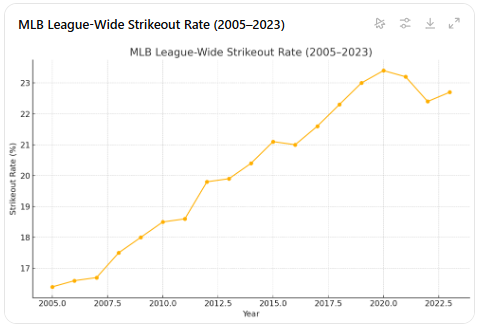
The Torpedo Bat: Repositioned Sweet Spot, Misplaced Solution
By Ken Cherryhomes ©2025
Preface
Over the last week, the Torpedo Bat has dominated headlines across MLB media outlets. With a sudden surge in home runs, glowing player testimonials, and the endorsement of a physicist credited with its design, it’s been framed as a potential breakthrough, a modern solution to an increasingly pitcher-dominated game.
But the public narrative has leaned almost entirely on surface metrics, anecdotes, and speculation. Little attention has been paid to the physics involved, the tradeoffs in swing profile, or the larger systemic causes behind mistimed contact and the rise in strikeouts.
This article is a follow-up to my earlier piece on the bat’s geometry and impact zone. Since then, I’ve re-examined the underlying assumptions, and performed my own tests simulating the mass redistribution used in the Torpedo Bat (video: soon to come). What I found is important: the bat isn’t expanding forgiveness. It’s moving the sweet spot to where mistimed contact already happens.
That doesn’t make it a gimmick. It makes it a workaround, a response to a symptom, not a correction of the cause.
The root problems remain: degraded swing discipline, early commitment approaches, and a velocity-dominated game that shrinks reaction time but still leaves room for better decisions. Repositioning the node may help certain hitters. But the better solution isn’t structural. It’s perceptual. It starts before the bat moves.
When Physics Meets the Field
There’s a lot of buzz surrounding the Torpedo Bat, a flared, mid-loaded design that’s been spotted in MLB dugouts and featured in major sports media. The bat is being hailed as a breakthrough, a reengineered silhouette designed by a physicist, backed by player testimonials, and credited with early-season power surges.
But marketing momentum is not the same as empirical validation.
I haven’t tested the bat directly, but I’ve reviewed the reports, studied the construction details, and conducted controlled experiments replicating its core design logic. My analysis isn’t a rejection of novelty. It’s a framing of function.
Does this bat offer something new? Yes. But does it offer what the narrative claims? That depends on what problem we believe it’s solving.
More Barrel Does Not Mean More Sweet Spot
One of the core misconceptions around the Torpedo Bat is that reshaping the barrel to create more surface area automatically increases forgiveness. It doesn’t. There’s a difference between surface and sweet spot, and it’s not subtle.
The optimal collision zone on a bat, the sweet spot, is defined by the convergence of two things: the center of percussion and the vibrational node. This zone does not grow with barrel size or material composition (metal bats) as some may believe. It shifts only when the bat’s mass profile and geometry change. Otherwise, its position and size remain tightly constrained, generally six to seven inches from the barrel end on standard bats. In contrast, the Torpedo Bat’s sweet spot is repositioned some 11–14 inches from the barrel’s end, but its area remains approximately 3 inches of space on the barrel, identical to the standard bat’s sweet spot size.

By swelling the mid-barrel and removing mass from the tip, the bat concentrates its weight around the zone where hitters now most frequently make contact. And given the rise in pitch velocity, that contact is often late, slightly below the traditional node.
So, what happens when mass moves down? Based on both physics and personal test results, the node follows.
I tested this myself using an aluminum bat with an internal sleeve many years ago. By shifting the sleeve downward inside the barrel, I measured the vibrational response before and after. The node had moved. Contact that previously felt flush now stung, and contact below the prior sweet spot now felt clean. The sweet spot didn’t expand. It drifted.
And that’s the critical point. The bat didn’t become more forgiving. It just moved the consequences. A late swing now connects near the relocated node. The player perceives better contact. The bat gets credit. But nothing in the swing improved.
Node Shift by Design, Not Accident
The Torpedo Bat’s defining characteristic is not its shape. It’s its admission. By concentrating mass where hitters now most often make contact, the bat does innovate—by way of concession. It accepts that today’s hitters are routinely late and redesigns itself around that flaw.
This isn’t compensation for mechanical inefficiency. It’s a workaround for temporal failure. The design doesn’t challenge the swing or promote better decisions. It builds around the existing problem. Instead of guiding the hitter toward better timing, it moves the sweet spot to match their worst habits.
The node shift isn’t a side effect of some new shape. It’s the purpose behind the shape. By rebalancing the barrel, the bat redirects feedback away from mistimed contact and reframes it as solid. Late swings begin to feel flush. Perception improves. The problem doesn’t.
And that’s the real function of the Torpedo Bat. It doesn’t restore timing. It doesn’t foster discipline. It moves the zone of least punishment to where failure already lives, and takes the sting out of it.
Breaking the Map
For generations, hitters have trained with bats built around the same fundamental structure. The sweet spot has lived in the same place. The feel of good contact has remained constant. Through thousands of swings on tees, in cages, and in games, hitters develop a deeply rooted awareness of where that sweet spot lives. They don’t have to think about it. They know it.
That awareness isn’t mechanical. It’s internal. Proprioceptive. Their hands, arms, and torso all cooperate to deliver the barrel to that known collision point. Over time, that awareness becomes precise, reliable, and automatic.
The Torpedo Bat disrupts that.
By shifting the sweet spot several inches inward, it interferes with long-formed internal calibration. The swing may feel familiar. The mechanics may stay intact. But the collision no longer registers where the hitter expects. The feel of flush contact is relocated. The body’s reward system loses its anchor. This is a complete disruption in how the batter times swings and confirms the temporal and spatial decisions they made.
The hitter might execute the swing exactly as trained, but the barrel no longer delivers the same feedback. The bat has changed, but the map has not. And that dissonance introduces hesitation, second guessing, or worse—misfires that feel like success.
This isn’t just a new feel. It is a neurological contradiction. What once felt right now feels wrong. What once rewarded timing now rewards failure.
And for most hitters, that is not an adjustment. It is a breakdown.
Alabama Chrome and the Strikeout Era
There’s a deeper issue here, and it goes beyond barrel shape or node behavior. The modern game is drowning in strikeouts. We’re not just seeing more mishits. We’re seeing more misses. Swinging strikes due to early committal. Late decisions. Poor recognition.
That’s not a physics problem. It’s a cognitive one.

The philosophy being taught now encourages early commitment. “See it early, commit to swinging, then adjust.” In theory, it’s designed to catch up to velocity. In practice, it short-circuits the decision process. It forces hitters to guess, not adjust. Remember, there’s a difference between being prepared and anticipating as opposed to anticipating and committing.
The Torpedo Bat, in this environment, makes a lot of sense—for the wrong reasons. It doesn’t solve the swing decision crisis. It dulls its sting. It’s Alabama Chrome: duct tape on a broken process.
So yes, maybe the late barrel contact feels better. But nothing in the swing strategy has changed. The hitter still guessed. Is that truly a win?
A Natural Geometry, Disrupted
Some of the most effective bat profiles in baseball history reflect a principle that appears not to have been intentionally engineered, but discovered through repetition and refinement—an intuitive accident. That’s how I see bat design: not theorized in a lab, but shaped by what performs across thousands of at-bats. The proportions of these bats often resemble a structure found throughout nature, known as the golden ratio.

I analyzed a G174 model used by Jeff Cirillo during his time with the Brewers. It is a variation of the C271, one of the most widely used models in professional baseball, but with a slightly elongated barrel and a modified handle. After mapping the center of oscillation and both vibrational nodes, the balance point landed 22 and two thirds inches from the knob and 11 and one third inches from the barrel end. These measurements align with the golden ratio, a proportion of roughly 1.618 found in everything from seashells to architecture to structural balance in tools and weapons.

These were not one-off prototypes. They were common models, refined by use and selected over time not for aesthetics, but for function. The structure of these bats naturally divides into zones—one for control, one for whip, and one for collision. Hitters didn’t need to chase surface area, because the geometry already worked.
The takeaway is simple. Effective bat design doesn’t need to chase novelty. It emerges through convergence, when hitters, across years and thousands of at-bats, select what performs. The C271, the G174, and bats like them weren’t engineered with this geometry in mind. They gravitated toward it because results demanded it.
The Torpedo Bat, by contrast, distorts that structure. It pushes mass inward, exaggerates the geometry, and shifts the bat away from what decades of elite hitters have already proven. It is not an evolution. It is a departure.
Nature has already solved for balance. If a new design is going to challenge that, it needs more than explanation. It needs proof.
Placebo Effects and the Post Hoc Trap
Much of the buzz around the Torpedo Bat has been fueled by anecdotal success. The Yankees’ early season power surge. Giancarlo Stanton’s postseason slugging. Players claiming the bat feels better or swings like their old bat, just better. These testimonials are loud. But they are not evidence.
Here’s the problem:
Player uses new bat. Player hits well. Bat gets credit.
That is a textbook post hoc fallacy.
No controlled testing. No A/B comparison. No counterfactual. Just narrative. And once players adopt a new tool—especially one generating headlines—there is psychological incentive to believe it is working. Add the timing of a few hot games, and it becomes gospel.
Placebo effects in baseball are common. Bat feel or visual profile can alter perception. But subjective feel does not change physical performance unless it alters actual mechanics. If a hitter times a pitch well and catches it flush, the bat benefits. If he doesn’t, no amount of cosmetic rebalancing will save the result.
If the mass distribution doesn’t change the collision profile or sweet spot physics, then the performance gains must be perceptual. And perceptual advantages only matter if they change how a hitter swings—not just how the bat feels in his hands.
The real test is not whether a few hitters had success. The real test is whether this design solves for performance constraints across hitter profiles and within the laws of physics. So far, that evidence does not exist. The perception of performance is doing all the work here, not the physics.
A Novel Shape or a Mirror?
The Torpedo Bat doesn’t rewrite collision physics. It doesn’t increase sweet spot size, change how energy transfers, or alter the consequences of poor timing. What it does is reposition tolerance.
That repositioning may benefit a certain kind of hitter, one who is consistently late. For that hitter, the bat feels better because it follows their flaw. Not because it corrects it.
But let’s not confuse this for progress. It’s not a new tool for better swings. It’s a tailored response to an epidemic of mistimed ones.
The silhouette is novel. The outcome is not. This is not a breakthrough in performance. It’s an accommodation of decline.
And decline, no matter how cleverly designed around, is still decline.
Conclusion: A Shift in Tolerance, Not a Correction of Cause
The Torpedo Bat is not a gimmick. It’s a legitimate innovation. The design reflects a clear understanding of mass distribution, inertial tuning, and barrel physics. For hitters who are consistently late, and there are many, it might feel like a breakthrough. But feeling better and performing better are not synonymous.
The problem this bat addresses is real. Contact for some has drifted. Event time has compressed. Pitch velocity is higher, and swing decisions are being made earlier, with less information. But while those constraints are modern, they aren’t unsolvable. Hitters still have time to decide, just less of it. And there are better ways to use that time.
What the Torpedo Bat does is simple: it meets the hitter at the point of failure and makes that failure feel less costly. It moves the node to where late swings now land. That doesn’t eliminate the flaw. It just reduces the punishment.
That’s not a bad idea. But it’s not a comprehensive one either. It’s clever, and for some, it’s effective. But it’s a duct tape fix, a layer of engineered forgiveness covering up a deeper strategic breakdown. It doesn’t change the philosophy that causes the failure. It just treats the aftermath.
The strikeout era wasn’t born from mishits. It came from misreads. It came from early commitment, from swinging before recognizing, from institutionalizing aggression as discipline. Reconfiguring the bat to follow a mistimed swing won’t pull baseball out of this hole.
Recognition is the fix. Timing is the fix. Deciding better is the fix.
Innovation matters. But only when it moves the game forward. Moving the node is a clever response to today’s contact patterns, but it doesn’t realign them. It follows a failing pattern and makes it more tolerable.
And the cost of tolerating failure is that you stop addressing it.